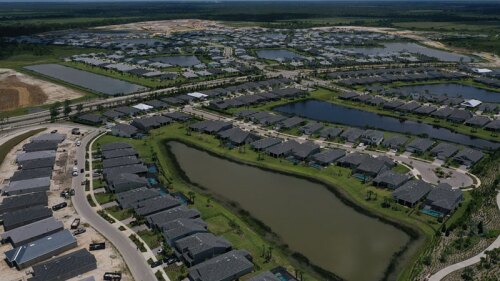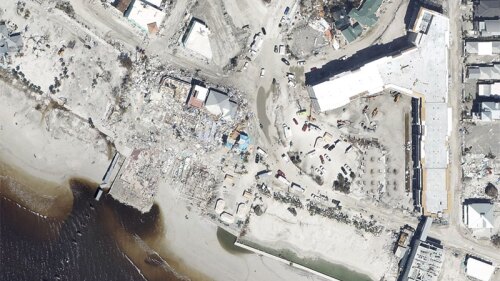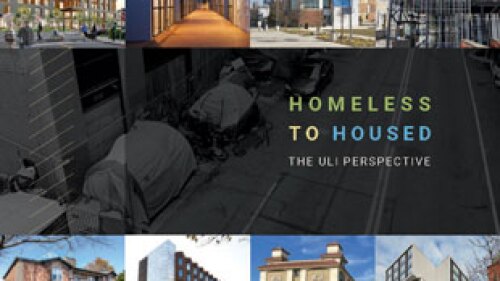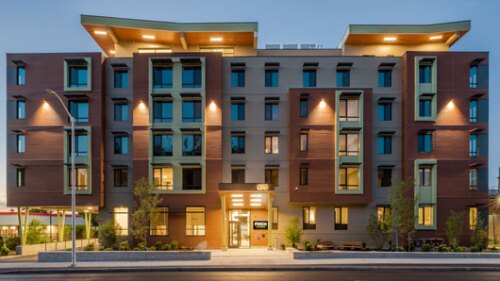
Railroad tracks separate the northern side of Lamar from the southern side, where most of the town’s amenities are. From left: Kathleen McCormick; Hillary Fulton, senior program officer for healthy living with the Colorado Health Foundation; Emily Nieschburg of the High Plains Community Health Center; Michael Horst, ULI senior vice president for the Larsen Leadership Initiative; and Kyle Legleiter, senior policy officer, Colorado Health Foundation.
A harsh wind—as well as a highway and railroad—slice through town. How can residents be enticed to get out and move?
A walk down Main Street in Lamar with a late winter storm blowing in tells a lot about the challenges of trying to exercise in this rural city on the southeastern Colorado plains. Conditions may include 50-mile-per-hour (80 kmph) sandstorms, 18-wheelers blasting past at similar speeds, and for pedestrians, a dangerous situation caused by the lack of sidewalks, bike lanes, and safe crossings on this five-lane roadway, which also serves as U.S. Highway 50/287.
For a week in April, members of a ULI Advisory Services panel toured Lamar, listened to community leaders and residents about Lamar’s hopes and challenges, and made recommendations for changes to the built environment that would encourage people to get out and exercise.
Related Content: Health in the Suburbs: Arvada, Colorado
Related Content: Health in the City: Denver’s Westwood
Lamar is one of three communities selected to participate in the Colorado Health Foundation (CHF) Healthy Places: Designing an Active Colorado initiative, a five-year, $4.5 million program that aims to reduce and prevent obesity by fostering a built environment in which it is easier to walk, play, and engage in daily exercise and a healthy lifestyle.
Founded in 1886, Lamar is a historic crossroads city on the Santa Fe Trail. Located in the Arkansas River Valley about 20 miles (32 km) west of the Kansas border, Lamar covers 4.2 square miles (11 sq km) and has a population of about 7,900, down from 8,900 in 2000. Colorado Springs, the nearest big city, is a two-hour drive away. Lamar is the county seat of Prowers County (population 12,500), which has a density of only 7.6 residents per square mile.
Numerous studies have linked obesity and related chronic diseases with poverty. According to U.S. census data, in 2010 nearly 24 percent of Lamar residents lived below the federal poverty level—almost twice the poverty rate for Colorado (12.6 percent) and the United States (14.3 percent). One in three Lamar children lives in poverty, one of the highest rates in the state. The obesity rate is 39 percent; another 30 percent are overweight.
Lamar’s Challenges for Active Living
A culture of driving reigns in Lamar, partly because of the climate, but also because of physical barriers such as high-volume and high-speed traffic on Main Street; long city blocks; lack of sidewalks, crossings, and bike paths; and the railroad tracks that divide the city into what locals call the north side and the south side.
“The biggest barrier we hear about is the inability to walk or bike to work, to home, or to the grocery store,” said Karen Bryant, chief operating officer of the Prowers Medical Center and a member of Lamar’s Healthy Places Steering Committee and its precursor, LiveWell Prowers County Coalition, which invited the ULI panel. “There’s nothing connecting the north and south side of town. You have to cross the railroad tracks.”
Lamar has made some strides toward becoming healthier, with walking clubs, biking groups, wellness programs, and new park facilities, she said. But especially for residents north of the tracks, there are few safe connections to parks, school playgrounds, and recreation facilities. The south side is the site of most of these facilities, including a four-field baseball complex, a football stadium and track, a community center with a gym and weight/exercise rooms, and the city’s main civic gathering space, Willow Creek Park, a leafy location with a swimming pool, a Frisbee golf course, and sports courts.
North side resident Renee Reyez-Lopez said her family does not walk anywhere because “we don’t have many sidewalks, and the ones we have are uneven, chipped, and cracked.” Streetlights are inadequate, and unrestrained dogs are a problem. She drives her two young sons to school “because the roads aren’t safe, and people don’t respect kids on bicycles.” The boys play soccer at the nearby Escondido Park, but the only close playground equipment is in poor condition. Her wish list includes sidewalks, marked bike lanes, a playground, and safe street and railroad-track crossings.
Affordability is another huge barrier, said Emily Nieschburg, a nutritionist and diabetes educator for the High Plains Community Health Center, and a member of Lamar’s Healthy Places Steering Committee. “This is a community in survival mode,” she said. “Healthy living isn’t at the top of the priority list. People can’t afford or don’t have access to healthy food or can’t find the time to exercise.” Paying to work out at the community center also is not an option for many residents, she said. On the plus side, she said, “we have amazing partnerships. If you came here three years ago, health wasn’t part of the conversation. We’ve put value on it, which is a big shift.”
ULI Panel and Recommendations
The Lamar ULI Advisory Services panel, chaired by ULI senior resident fellow Ed McMahon, interviewed more than 70 public officials, city staff, school and health care administrators, economic development staff, residents, and parks/recreation and wildlife division staff. Other panel members were Laura Burnett, landscape architect and principal of Burnett Land & Water in San Diego; Tom Cox, consultant and former chief of staff to former Pittsburgh mayor Tom Murphy; Brian Guenzel, planner and director of the Institute of Urban Studies at the University of Texas at Arlington; Michael Horst, senior vice president of ULI’s Larson Leadership Initiative; Andrew Irvine, landscape architect and principal of RNL Design in Denver; Brad Rogers, community project manager for the Eastern Shore Land Conservancy in Queenstown, Maryland; and Ed Starkie, development financial adviser and principal of Urban Advisors in Portland, Oregon.
The panel’s recommendations focused on several big takeaways, said Thomas Eitler, ULI vice president for Advisory Services. First, he said, Lamar needs to address its poor economic health. The loss of manufacturing jobs and the effect of drought on agriculture and ranching have meant fewer businesses, fewer people employed and working downtown, declining tax revenues, and deteriorating housing stock and physical infrastructure. Many of Lamar’s young people move away for college and job opportunities; few return. These characteristics, he noted, are shared by many rural towns isolated from large metropolitan areas.
The panel recommended a “21st-century economic development model” focused on making the city more attractive and walkable by promoting its distinctive characteristics—its history as part of the Santa Fe Trail and the Great Depression’s Dust Bowl, the Arkansas River, and other assets—through public/private partnerships among the city and county governments, the chamber of commerce, the parks and recreation department, hospitals, the community college, and community organizations. This model would put the city’s basic infrastructure, skilled workforce, and solid education level—80 percent of adults have a high school degree, and 18 percent have a college or advanced degree—to good use in highly focused recruitment of businesses and jobs.
“The ability to revitalize has a direct impact on the health of residents,” the panel noted in its report. An attractive, walkable environment would encourage more physical activity and attract new types of business by meeting the needs of the future workforce. The result would be new opportunities that could lead to a livelier Main Street retail environment, more tax revenue, more jobs, higher incomes for residents, and the ability to invest to improve the quality of the streets, businesses, and housing stock.
The ULI panel also focused on neighborhood renewal and connection—what it called “enhancing the soul of the community.” Key recommendations included:
- Connect all parks, schools, grocery stores, and institutions into one walkable and bikeable network that would be greater than the sum of its parts. Create a master plan for parks and trails that would incorporate new developments and opportunities into the existing park framework.
- Provide safe, connected walking and biking routes to encourage people to get out of their cars. Employ traffic-calming measures; add bike lanes and buffers, and safe crosswalks and sidewalks on Main Street and in the downtown neighborhood grid; and upgrade Main Street to create attractive gateways to Lamar.
- Create a seven-mile (11 km) multiuse loop trail for walking, biking, and equestrian use as a central organizing feature that would connect the north side’s Escondido Park and the south side’s parks and recreation facilities to an existing greenway along the west side and an existing canal trail on the east side of the city. Encourage use of the trail as a safe route to school and work, as well as for city events and sports activities.
- Add judiciously to the park network, and provide better access to open space, using signs, lighting, and walking paths to increase its use and visibility. Include in the plans Valco Ponds Open Space—an underused natural area next to the Arkansas River on the north side of the city that Colorado Parks and Wildlife is donating to Lamar—and create a wildlife observation trail there.
- Complete the south side’s baseball complex, where two fields are still without turf, and add two more playing fields and water, electricity, and a playground to the north side’s single soccer field at Escondido Park.
- Enhance existing assets like parks, greenways, and recreation spaces. To encourage longer visits, provide amenities such as lighting, benches, shade, water fountains, and restrooms. Activate parks and trails with races, rides, picnics, block parties, music performances, and other low-cost activities.
- Use parks, recreation, and health as an economic development tool, encouraging nature tourism with birding, hunting, and fishing. Expand sports tourism, for example, by holding a Ciclovia street festival that turns the streets over to cyclists, as well as pedestrians.
- Provide better access to healthy food through safe pedestrian connections to grocery stores and community gardens. Continue to build model community gardens at the south-side medical center and north-side HOPE Center, an after-school and family education and activity center. Expand the number of community gardens in order to provide fresh produce in neighborhoods, and allow for a local farmers market.
- Build neighborhood identity and leadership. On the north side, expand neighborhood resources near the HOPE Center with a garden market, an aquaponics greenhouse, a park, and a tree nursery.
“Our biggest goal for Healthy Places is, will what you’re proposing lead to increased physical activity among residents?” said Kelly Duncan, CHF vice president for philanthropy. Duncan said the ULI panel recommendations that were especially strong, such as the Lamar Loop Trail, related to connecting existing assets, which would galvanize people to make their city better. “We are really encouraged by the engagement of Lamar’s residents in this process,” she said. “We believe it will lead to changes in the built environment so residents can become more active on a daily basis.”
Eitler said, “In planning for healthy communities, we’re finding the intersecting standards from medical, government, and nonprofit community organizations are different than the standards we use for making recommendations for TODs [transit-oriented developments] or traditional neighborhood design. Lamar has provided good perspective and helped us realize that some of the best practices for larger urban places can be applied to small rural communities.”
The Building Healthy Places Initiative leverages the power of ULI’s global networks to shape projects and places in ways that improve the health of people and communities. Learn more.






